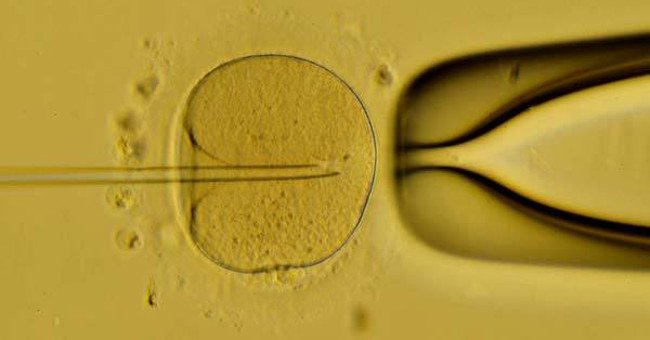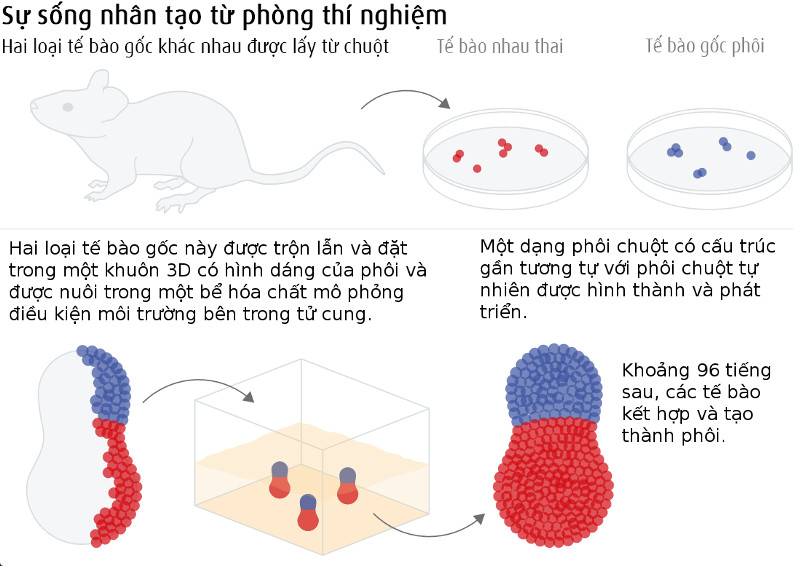A human can be created from a laboratory, without eggs and sperm
Recently, scientists from Cambridge University have successfully created mammalian embryos based solely on stem cells. This is a breakthrough in biotechnology, opening up hope to create a successful "artificial person" in the lab in the future if allowed.
The expert team mixed two types of mouse stem cells and put them on a 3D "scaffold". Early cells formed the structure of living mouse embryos after four days of growth in a chemical tank designed to simulate environmental conditions inside the uterus.

The process of artificial insemination.
This method allows scientists to develop artificial human embryos in the laboratory without sperm or eggs.
In addition, the current embryo culture also gives them the opportunity to learn more about the early period in the process of forming human life. From there, find out the cause of miscarriage and give a remedy.
Currently, scientists often use leftover products after the process of artificial insemination to perform embryo research. But the number of such embryos is always scarce and often destroyed after 14. Therefore, the ability to create countless artificial embryos in the laboratory can accelerate research.
The development of life in the laboratory has many benefits but will also raise controversy over ethics.
Embryos made from stem cells in this successful experiment were genetically engineered with cells, forming a placenta similar to that of a woman's pregnancy. Previously, scientists who tried embryonic development only relied on stem cells but were unsuccessful, because the cells at that time did not assemble exactly at the necessary locations. But after they added to the "placental" stem cell mixture, they began to grow together.

Placental cells and embryonic stem cells combine to form the embryo structure, with two separate cell clusters at each end and a gap in the middle, which is the space where the embryo continues to grow. Due to the lack of yolk-forming stem cells, this embryo cannot develop into a mouse.

There are a lot of criticisms about intervention in embryos, they fear that this will open the door to a future in which newborn babies are designed according to their parents' ideas, creating people. transcendence thanks to genetic modification. If scientists want to create fetal human embryos in the laboratory need to get approval from the Human Reproductive and Embryo Agency (HFEA).
- Close-up of the transformation of the human body after death
- It turns out that human stem cell transplantation can help reduce spinal cord injuries in mice
You should read it
- [Infographic] Benefits and hazards from Artificial Intelligence
- Artificial intelligence algorithms read human thoughts
- Artificial intelligence discovers the unprecedented human ancestors
- Successfully created human kidney tissue from stem cells
- Can people and robots give birth together in 100 years?
- Artificial intelligence learns to create another artificial intelligence, replacing people in the future
- Successfully manufactured human ear from apples
- Artificial 3D printed hearts work almost like human hearts
May be interested
- For the healthiest sperm, men go to sleep at this 'golden time'
 sperm will be healthy and have the best movement speed if gentlemen go to bed between 8 and 10pm.
sperm will be healthy and have the best movement speed if gentlemen go to bed between 8 and 10pm. - Is egg yolk really beneficial or harmful?
 eat boiled eggs instead of frying, because peach eggs do not lose the essential nutrients needed. however, not all eggs can be re-eaten and everyone is fit to eat it.
eat boiled eggs instead of frying, because peach eggs do not lose the essential nutrients needed. however, not all eggs can be re-eaten and everyone is fit to eat it. - Sperm also has a 'switch' that helps to turn on and off
 scientists have discovered that sperm switches that work on and off can work to prevent sperm from reaching the egg. this can be a safe and effective contraceptive on the body of both men and women.
scientists have discovered that sperm switches that work on and off can work to prevent sperm from reaching the egg. this can be a safe and effective contraceptive on the body of both men and women. - 8 habits when processing eggs harmful to health you need to quit immediately
 eggs are a nutritious food and can be processed into many attractive dishes. but if not properly cooked you will reduce the nutrients in the eggs and even poison your own body.
eggs are a nutritious food and can be processed into many attractive dishes. but if not properly cooked you will reduce the nutrients in the eggs and even poison your own body. - Is eating raw eggs beneficial or harmful?
 chicken eggs are one of the healthy foods that contain many healthy nutrients. many people often have a preference to eat or drink raw or rare eggs. so is it good to eat raw eggs?
chicken eggs are one of the healthy foods that contain many healthy nutrients. many people often have a preference to eat or drink raw or rare eggs. so is it good to eat raw eggs? - How long can eggs stay fresh? How to best preserve eggs?
 egg freshness can be maintained for a period of 2 hours to a maximum of 1 year, depending on where you buy it and how you store it.
egg freshness can be maintained for a period of 2 hours to a maximum of 1 year, depending on where you buy it and how you store it. - Successfully created human kidney tissue from stem cells
 for the first time, scientists have succeeded in developing kidney tissues that act as human kidneys in a laboratory capable of producing urine.
for the first time, scientists have succeeded in developing kidney tissues that act as human kidneys in a laboratory capable of producing urine. - Need to be careful when using eggs
 using eggs incorrectly can cause bad effects on your body's health
using eggs incorrectly can cause bad effects on your body's health - Germany successfully created the 'black hole' in the molecule with the world's most powerful X-ray beam
 a molecular black hole has been successfully created by german scientists in the laboratory by projecting the world's most powerful beam of x-rays.
a molecular black hole has been successfully created by german scientists in the laboratory by projecting the world's most powerful beam of x-rays. - Scientists successfully cultivate the perfect human vascular system in the laboratory
 researchers from the university of british columbia, canada have successfully developed the first artificial human vascular system from stem cells in the laboratory. the study was published in the journal nature.
researchers from the university of british columbia, canada have successfully developed the first artificial human vascular system from stem cells in the laboratory. the study was published in the journal nature.










 The genetic variant was found to be associated with viral inflammation
The genetic variant was found to be associated with viral inflammation Found enzymes that eliminate cholesterol help prevent brain damage
Found enzymes that eliminate cholesterol help prevent brain damage Finding proteins with new therapeutic potential for asthma patients
Finding proteins with new therapeutic potential for asthma patients Probiotic beneficial intestinal bacteria can help reduce seasonal allergy symptoms
Probiotic beneficial intestinal bacteria can help reduce seasonal allergy symptoms To prevent cancer, increase the use of these foods
To prevent cancer, increase the use of these foods 5 items near the bed increase your risk of cancer
5 items near the bed increase your risk of cancer